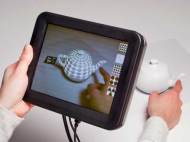REVEL technology – haptic feedback on almost every surface
 Technology developed by Disney Research could be used to provide advanced tactile feedback to real-world surfaces and objects, including touch-screens, walls, furniture, wooden, or plastic objects, without requiring users to wear special gloves or use force-feedback devices. Named REVEL, the technology employs reverse electrovibration to create the illusion of changing textures as the user’s fingers sweep across a surface.
Technology developed by Disney Research could be used to provide advanced tactile feedback to real-world surfaces and objects, including touch-screens, walls, furniture, wooden, or plastic objects, without requiring users to wear special gloves or use force-feedback devices. Named REVEL, the technology employs reverse electrovibration to create the illusion of changing textures as the user’s fingers sweep across a surface.
“Augmented reality to date has focused primarily on visual and auditory feedback, but less on the sense of touch”, said Olivier Bau, a postdoc at Disney Research, Pittsburgh. “Sight and sound are important, but we believe the addition of touch can create a really unique and magical experience.”
The electrovibration effect was first defined back in 1953, and it’s a sensation that you already might have felt if you slide a finger across a smooth metal surface of an ungrounded electrical appliance. When dry, outer layer of skin serves as an insulator, and a small alternating current applied to the conductive metal surface can generate an attractive force between the surface and a small electrical charge induced in the fluids of the finger’s deeper tissues as the finger moves across the surface.
Although no current actually passes through the skin, and the amount of induced charge is negligible, out perceptions makes us believe that the surface we’re interacting with is rubbery. By tracking the finger’s position using an external sensor, such as a Microsoft Kinect, the researchers can manipulate the electrovibration effect to create an illusion of bumps, edges or changes in texture corresponding to particular locations on the surface that can be felt by the user.
“The amount of current used is extremely low — in the microampere range”, said Ivan Poupyrev, a senior research scientist at Disney Research, Pittsburgh. “The static electric spark we feel when touching a doorknob, by comparison, is a higher current and, even so, presents no health and safety concerns.”
Anodized aluminum objects or capacitive touch-screens can be used without any modification, while other surfaces require no extensive modification. Other surfaces need to be coated with an insulator-covered electrode which is dubbed as REVEL skin by the researchers. One simple method is to coat a surface with a conductive paint and add a coat of conventional household paint as an insulating layer. The surfaces must also share a common electrical ground with the REVEL signal generator in order to work as envisioned.
Disney Research REVEL technology could be used to add haptic feedback to games, apply texture to projected images on surfaces of any size and shape, provide customized directions on walls for people with visual disabilities and enhance other applications of augmented reality. Another benefit over other currently available haptic technologies is the fact it can be scaled up and easily applied onto almost any object or surface anywhere in the environment.
For more information, you can read the research paper: “REVEL: Tactile Feedback Technology for Augmented Reality” [12MB PDF].









Very interesting, especially since it’s coming form Disney.